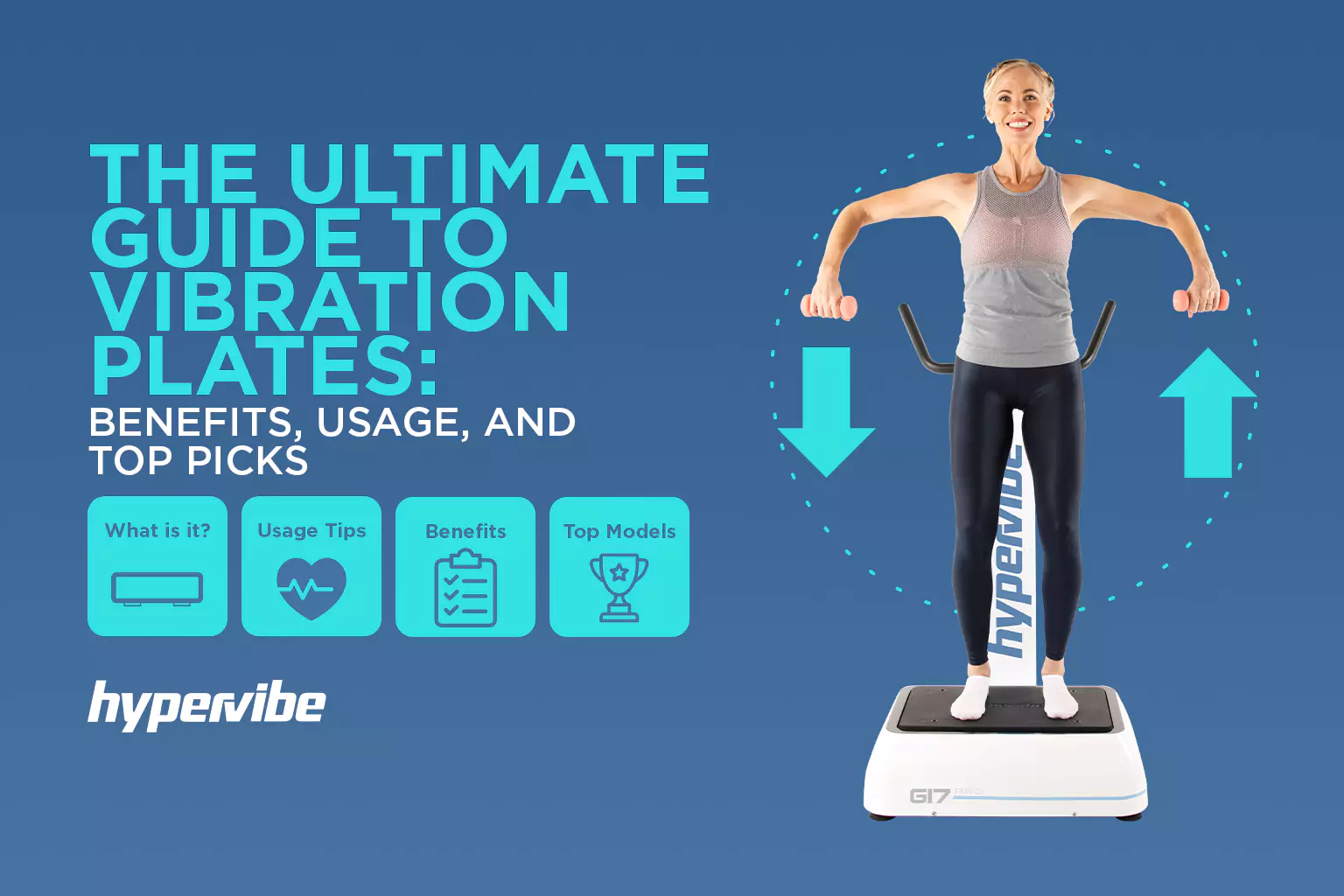
We are always looking for a way to boost our fitness, weight loss, or mobility.
Vibration Plates might be the answer.
A Vibration Plate (Vibration Platform or Whole Body Vibration Platform) is an exercise machine that, in most optimal cases, vibrates up to 25 times per second (25 Hz). With each cycle of vibration, the machine causes your muscles to contract rapidly and challenges your body to remain balanced.
This, in turn, makes your body use more energy.
Using a Vibration Plate is super easy; you can stand, squat, stretch, or perform bodyweight exercises on the vibrating surface.
A session can take as little as 10–20 minutes depending on your goal and fitness level, which makes it a quick and efficient wellness tool.
Not sure where to start? Here are three options to choose from:
In this guide, we will help you understand what a Vibration Plate is, how it works from a scientific perspective, and how you can get the best results from using it.
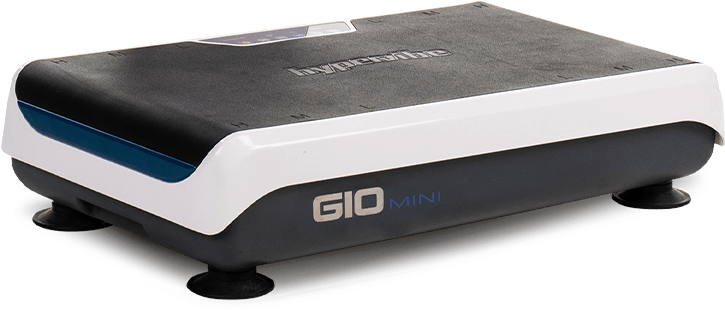




A Vibration Plate is a compact machine with a platform that vibrates up and down.
With each cycle of vibration, it places a force on your body, causing a wide array of bodily responses and effects.
The vibrational forces cause your muscles to contract and relax rapidly.
This contracting improves weight loss, bone density, muscle strength, mobility/flexibility, lymphatic function and circulatory system health, and balance responses in less time compared to traditional workouts.
Are Vibration Plates backed by science, and do they have tangible benefits for the body? Let us break down the scientific benefits in 60 seconds.
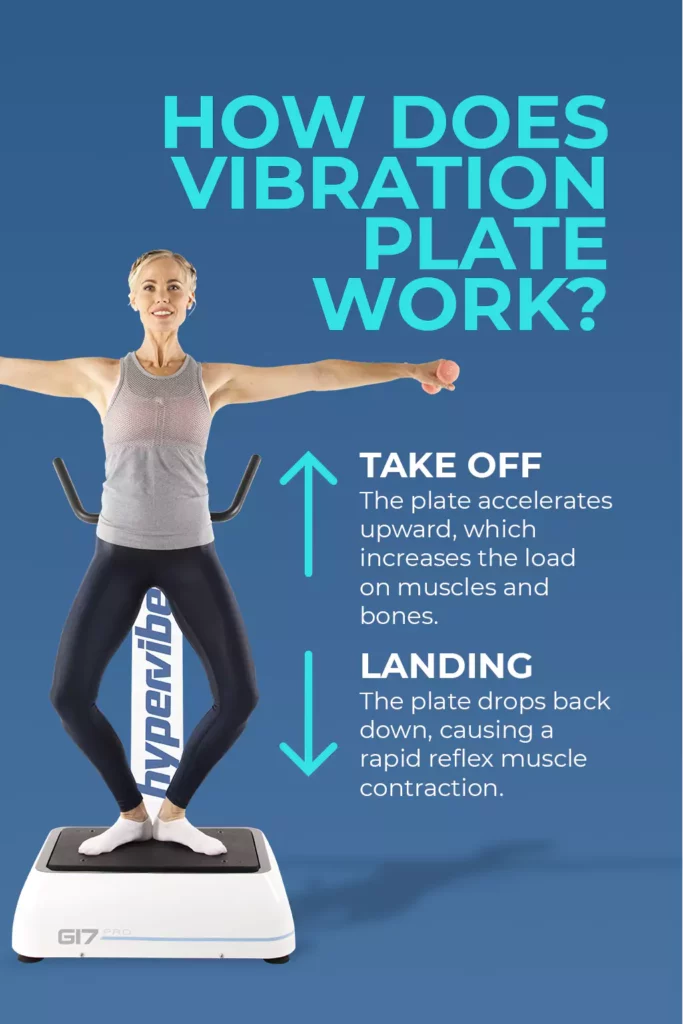
Infographic on how the pivotal vibration plate work when moving up and down
When the vibration plate lifts upward, your body momentarily experiences increased gravitational force, similar to feeling heavier when an elevator moves quickly upward.
This amplified gravitational load forces your muscles and bones to work harder, leading to increased muscle power and improved bone density.
Effective vibration plates produce accelerations much greater than gravity alone (up to 20G), crucial for maximizing these exercise benefits.
After lifting you, the vibration plate quickly drops, creating a brief moment of free-fall before you land back on the platform.
This sudden landing triggers a rapid stretch in your muscles and tendons, activating a reflex muscle contraction, similar to the knee-jerk reaction tested by doctors.
This reflexive contraction can be stronger than voluntary muscle contractions, significantly boosting muscle tone, balance, and power.
The effectiveness of Whole Body Vibration depends on getting two factors right: acceleration (how powerfully the machine moves you up and down) and frequency (the speed of these vibrations, ideally between 20-45 Hz).
When both factors are optimized, vibration plates deliver proven improvements in muscle strength, bone density, balance, and overall physical performance.
Understanding precisely how a vibration plate works helps demystify its health claims, confirming why over 400 research studies endorse Whole Body Vibration as an effective, time-efficient exercise solution.
The platform’s rapid movements stretch muscles, provoking quick, involuntary contractions.
This is very similar to when a doctor hits your knee with a reflex hammer.
This reflexive response builds neuromuscular strength.
Increasing vibration G-Force heightens muscle contractions, which can support bone density, boost metabolism, and aid circulation and lymphatic drainage.
Vibration loosens connective tissues, fascia, and muscles, leading to better flexibility and mobility.
Clinical trials show stretching on Vibration Platforms improves range of motion more than stretching alone.
The shifting surface causes your body to continuously make balance adjustments, engaging stabilizing muscles and improving posture and balance responses.
Studies demonstrate gains in stability and sit-to-stand performance after Vibration Training.
Vibration stimulates sensory receptors, which can override pain signals.
Trials have demonstrated reduced pain and increased pain thresholds in chronic conditions like osteoarthritis and low back pain.
As vibration interacts with your body, part of the energy is absorbed by your tissues and converted into heat.
Warm muscles and joints tend to move more comfortably and efficiently.
Whole Body Vibration has been shown to generate this warming effect quickly, effortlessly, and safely compared to most traditional exercises.
Regular vibration exposure has been shown to increase growth hormone and testosterone levels, supporting muscle gain and overall vitality.
Vibration Training may slightly elevate epinephrine and cortisol and may create a healthy stress hormone response and better physical performance.
Though research is emerging, it aligns with known benefits of sensory-based practices.
While some skepticism surrounds vibration plates, numerous studies suggest they can be effective when used correctly.
They are not a magic solution for weight loss or fitness, but they can complement a balanced diet and regular exercise routine.
Research that has been published supports the advantages of Vibration Training.
Here are several major physiological benefits that have been proven by peer-reviewed research.

relaxed African American man drinks water after a workout
While vibration plates can boost metabolism and aid in weight loss, they should not be relied upon as a standalone solution.
A balanced diet and regular cardio and strength training exercises are crucial for effective weight loss.
Incorrect use of vibration plates can lead to injuries, especially if pre-existing conditions affect your bones or joints.
It’s essential to learn the correct techniques and start with lower intensity to avoid any potential harm.
Step-equivalents (for effort comparison):
These figures are based on adult cadence research showing that ~100 steps per minute corresponds to moderate-intensity effort (≈3 METs).
Treat them as equivalents, since a vibration plate is stationary and won’t register literal steps.
Public-health translations use the same cadence to communicate guidelines, noting that ~3,000 steps in 30 minutes is a practical proxy for a daily moderate-intensity bout.
Direct answer: 0 miles (the platform doesn’t move).
Effort-based mile-equivalent for context:
Why this mapping:
Direct answer (10 minutes): Calories = 1.05 × your body weight (kg).
This uses our Hypervibe calculator method: Compendium MET for wbv-squats = 6.00 , then the standard kcal formula.
Per-minute rate: 0.105 × body weight (kg) kcal/min.
30 minutes: 3.15 × body weight (kg) kcal.
Examples (WBV squats at 6.00 MET):
Basis: Hypervibe’s calculator applies a WBV multiplier of 1.20 to Compendium MET baselines; selecting a WBV move like squats (5.0 MET) yields the rates above. Enter your exact weight and duration in the Hypervibe tool for precise values.
You could use our dedicated “Calories Burn Calculator” to calculate exactly how much calories you burned basesd on the moves, your weight and the duration of your WBV sessions.
Bonus: Even a single brief session can acutely improve flexibility and balance in RCTs; longer multi-week plans drive strength gains, especially ≥12 weeks.
Yes.
As an intensity multiplier: a verified 20-minute multi-exercise WBV session increased metabolic cost by ~20% vs the same routine without vibration,
so WBV augments the underlying exercise (walking, squats, lunges) rather than replacing it.
If you’re wondering how to use a Vibration Plate, you’re not alone.
These machines may look simple; however, you need to use them correctly to gain the maximum benefits and avoid injury.
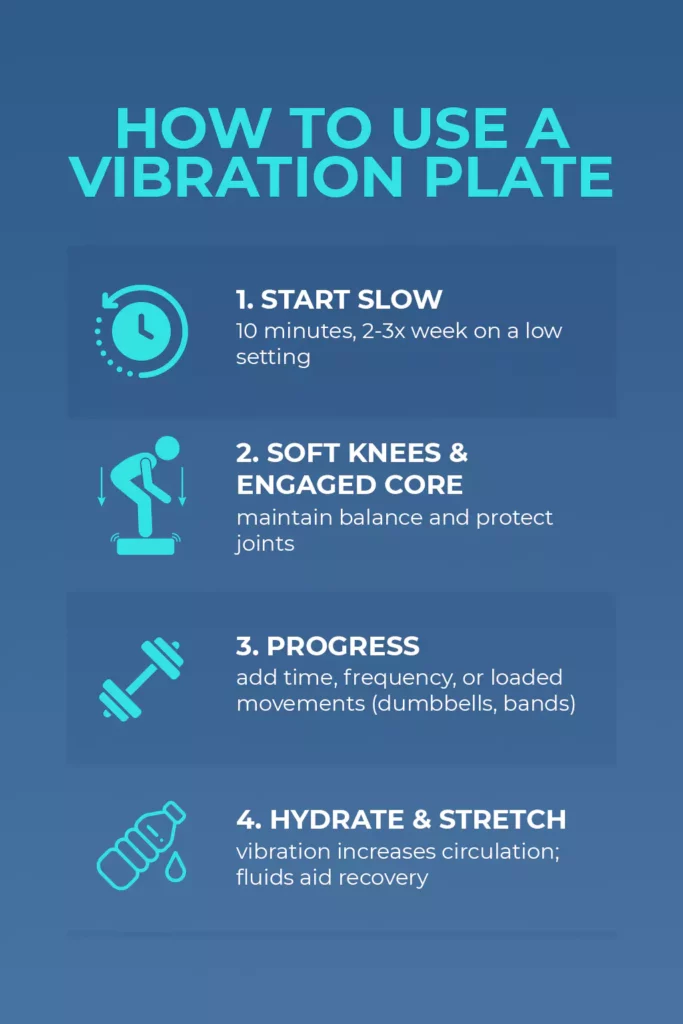
How to use a vibration plate 4-step beginner guide with tips for safe and effective workouts
If you’re just getting started, stick to this safe and effective intro routine:
If you are not using a Pivotal Vibration Plate, a Lineal one is the next best.
These are the most researched types of platforms on the market.
This will activate your muscles, improve circulation, and enhance mobility without overworking your body.
|
Week |
Session Time |
Frequency |
Focus Area |
|
1 |
3-5 mins |
5-15 Hz |
Standing/Squatting/Stretching/Massage positions. 1-2 minute rest between sets |
|
2 |
7-10 mins |
5-22 Hz |
Standing/Squats/Stretching/Massage positions/Pushups/Triceps Dips/Basic Core. 1-2 minute rest between sets |
|
3 |
10-15 mins |
5-30 Hz |
Standing/Squats/Stretching/Massage positions/Lunges/Pushups/Triceps Dips/Basic to Intermediate Core. 1-2 minute rest between sets |
|
4 |
15-20 mins |
5-35 Hz |
All of the above with 30-second rest periods |
Vibration Plates are safe for everyone unless contraindicated.
Here are some contraindicated conditions that require medical consultation before attempting Vibration Training:
Pro tip: If you are okay to use a Vibration Plate, never lock your knees or elbows.
Also, don’t place your head directly on the plate, and use a yoga mat for bony surfaces (ex. elbows during plank).
One of the best things about Whole Body Vibration is that it enhances common bodyweight resistance exercises.
Below are five foundational exercises designed to maximize Vibration Plate benefits.
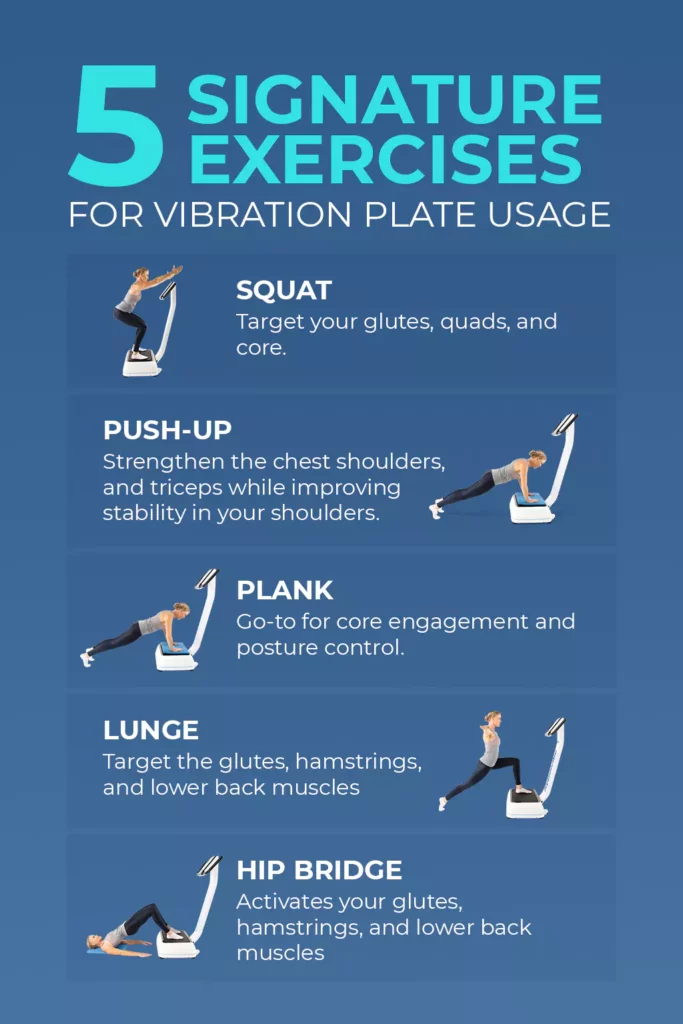
Infographic showing 5 signature vibration plate exercises squat, push-up, plank, lunge, and hip bridge
Squats target your glutes, quads, and core.
When you add vibration, it increases the load on your muscle fibers for better results.
How to do it:
Keep your spine aligned and engage your core by pulling your navel inwards and upwards.
Push-ups are great for strengthening the chest, shoulders, and triceps while improving stability in your shoulders.
Engage your core to avoid dipping your lower back.
This is a go-to for core engagement and posture control.
Don’t let your hips sag; if you do, it’s a sign your core is not fully activated.
Lunges target the glutes, hamstrings, and stability muscles in the hips and knees.
Use a support bar or wall if you need extra balance.
Activate your glutes, hamstrings, and lower back muscles with this routine.
It is great for counteracting long sitting hours.
Add a small cushion or mat under your shoulders for comfort.
Keep your core engaged.
Comparing vibration plates to traditional exercises can help you understand their unique benefits and limitations.
In conclusion, both vibration plates and traditional exercises have their place in a well-rounded fitness routine.
As a beginner, a low and well-supported routine is a great way to test the benefits of Whole Body Vibration.
Here is the full circuit you can try:
Perform all the exercises on the platform unless it is indicated to do them on the floor.
|
Exercise |
Time/Reps |
Hz Setting |
Tips |
|---|---|---|---|
|
Static Squat |
30-60 Secs |
5-15 Hz |
Keep knees soft and chest lifted |
|
Kneeling Push-Up |
8-12 reps |
5-15 Hz |
Kneel on the floor with your hands placed shoulder-width apart on the Vibration Plate. Engage your core and glutes to stabilize the body. |
|
Seated Core Hold |
30 sec |
5-15 Hz |
Sit on the Vibrating Platforms with hands and legs up to form a V. Ensure your core is engaged. |
|
Calf Raises |
12-15 reps |
5-15 HZ |
Stand with your feet hip-width apart on the platform and slowly raise and lower your heels. Ensure to keep your knees slightly bent. |
|
Child’s Pose Stretch |
30-60 sec |
5-15 Hz |
Heels on plate, squeeze glutes at top |
Do a two-minute warm-up before and a two-minute cool-down once you are done with the circuit.
For most healthy individuals, Vibration Plates can be used 3–5 times per week, depending on your fitness level and goals.
Beginners should start with 2–3 sessions a week to allow the body time to adapt.
Overuse can cause fatigue or muscle soreness, so it’s important to add rest days and monitor your body’s response.
A typical Vibration Plate session lasts 10 to 20 minutes.
If you are a beginner, start with 3-5 minutes of simple static poses or light exercises.
As your endurance improves, you can gradually increase time and intensity.
Keep in mind: more time doesn’t always mean better results.
The type of movement and form matter as well.
Vibration Plates primarily activate:
Because of the neuromuscular stimulation caused by Vibration Plates, most exercises engage multiple muscle groups simultaneously.
This makes Vibration Training effective even in short bursts.
Yes. They support weight loss by:
For safe and effective Vibration Plate usage, beginners should start with a frequency of 5–15 Hz.
This lower frequency helps your body adjust to the stimulus without overstressing it.
As you gain strength and endurance, you can increase the frequency to 22 Hz for greater muscle engagement.
If you’re searching for the best vibration platform for your home or clinic, here are our Vibration Plates top picks for 2025, reviewed for performance, comfort, durability, and price.
To compile our Vibration Plates top picks, we combined:
Our team prioritized devices that offer high g-force output, variable frequency, and a stable platform.
Warranty coverage, app integration, and ergonomics were also key.
|
Model |
Price |
Motion Type |
Frequency Range |
Max G‑Force |
Platform Size |
Warranty |
|
Hypervibe – G14 |
$3,129 |
Pivotal |
5–30 Hz |
14 g |
25.8” x 15.5” |
2/5/10 years |
|
PowerPlate – MOVE |
$2,896 |
Triplanar |
30-40 Hz |
6 g |
30” x 24” |
1 year |
|
Galileo® S 35 |
On request |
Pivotal |
5.33 Hz |
20.6 g |
27 x 19 |
2/10 years |
Vibration Plates are more than just a wellness trend; they’re a science-backed tool that supports:
Whether you’re starting a new fitness journey or upgrading your home gym, our Hypervibe Vibration Plates offer clinically supported performance trusted by professionals and health-conscious users worldwide.
Ready to experience the difference?
Visit the Hypervibe Shop and explore our full range of models designed for every lifestyle—from first-timers to elite athletes.
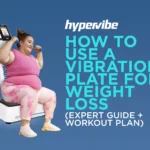
Here’s how we use a vibration plate for weight loss...
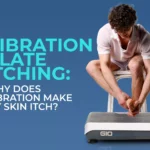
Many people, especially beginners, notice an itchy or tingling “pins-and-needles”...

Taking into consideration the growing popularity of the vibration plate,...

The lymphatic system, also called the lymphoid system, is an...
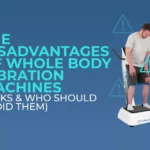
Are vibration machines bad for you? Yes, if used incorrectly....